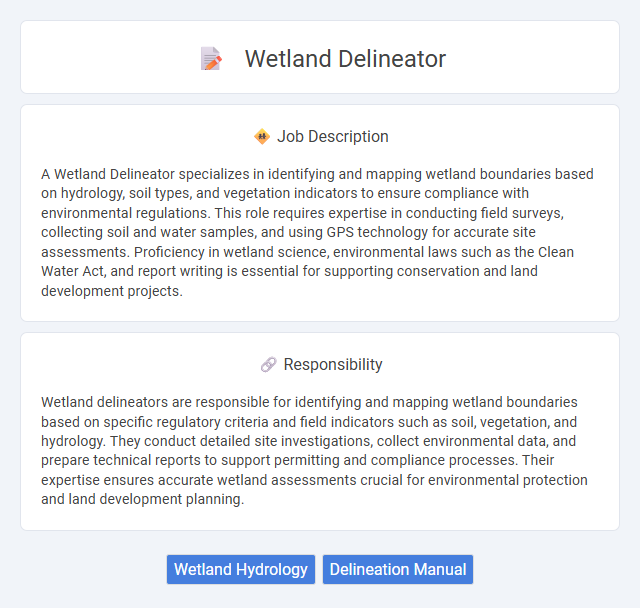
A Wetland Delineator specializes in identifying and mapping wetland boundaries based on hydrology, soil types, and vegetation indicators to ensure compliance with environmental regulations. This role requires expertise in conducting field surveys, collecting soil and water samples, and using GPS technology for accurate site assessments. Proficiency in wetland science, environmental laws such as the Clean Water Act, and report writing is essential for supporting conservation and land development projects.
Individuals who have strong observational skills and a keen interest in environmental science are likely to be suitable for a Wetland Delineator position. Those comfortable working outdoors in various weather conditions and capable of conducting detailed field assessments may find this role aligns well with their abilities. Candidates who prefer routine office work or have limited physical endurance might face challenges adapting to the demands of this job.
Qualification
A Wetland Delineator must possess a strong background in environmental science, ecology, or natural resource management, complemented by specialized training in wetland identification and regulatory requirements such as the Clean Water Act. Proficiency in GIS mapping, soil analysis, and plant identification is essential to accurately assess wetland boundaries and prepare detailed reports for regulatory agencies. Certification or professional credentials from recognized organizations like the Society of Wetland Scientists enhance credibility and demonstrate compliance with industry standards.
Responsibility
Wetland delineators are responsible for identifying and mapping wetland boundaries based on specific regulatory criteria and field indicators such as soil, vegetation, and hydrology. They conduct detailed site investigations, collect environmental data, and prepare technical reports to support permitting and compliance processes. Their expertise ensures accurate wetland assessments crucial for environmental protection and land development planning.
Benefit
Working as a Wetland Delineator likely offers significant benefits including the opportunity to engage in environmental conservation and land management, which may lead to a strong sense of job fulfillment. The position probably involves diverse fieldwork, enhancing skills in ecological assessment and regulatory compliance, valuable in environmental science careers. There is a reasonable probability for stable employment given ongoing demand for wetland protection and restoration projects across various industries.
Challenge
Wetland Delineator jobs likely involve navigating complex environmental regulations and accurately identifying wetland boundaries in diverse and often difficult terrains. Challenges probably include dealing with ambiguous field data and adapting to varying ecological conditions that require specialized knowledge and judgment. This role possibly demands thorough understanding of hydrology, soil science, and ecology to effectively support environmental planning and compliance.
Career Advancement
Wetland delineators who demonstrate expertise in hydrology, soil science, and botany can advance to senior environmental consultant roles or project management positions overseeing complex ecological assessments. Gaining certifications such as Certified Wetland Scientist (CWS) enhances credibility and opens opportunities in government agencies, environmental consulting firms, and conservation organizations. Continuous professional development in GIS technologies and environmental regulations supports career growth toward leadership roles and specialized wetland restoration projects.
Key Terms
Wetland Hydrology
Wetland Delineators specialize in identifying and mapping wetland boundaries based on hydrological data, vegetation types, and soil characteristics. Their expertise in wetland hydrology involves assessing water table fluctuations, seasonal inundation patterns, and surface water dynamics to determine wetland presence accurately. Proficiency in analyzing hydrologic indicators such as water marks, drift lines, and soil saturation is critical for ensuring compliance with environmental regulations and wetland conservation.
Delineation Manual
A Wetland Delineator uses the Delineation Manual to accurately identify and map wetland boundaries based on vegetation, soil, and hydrology criteria. This manual provides standardized methodologies essential for compliance with environmental regulations and wetland permitting processes. Mastery of the Delineation Manual ensures precise wetland assessments critical for habitat conservation and land development planning.
 kuljobs.com
kuljobs.com